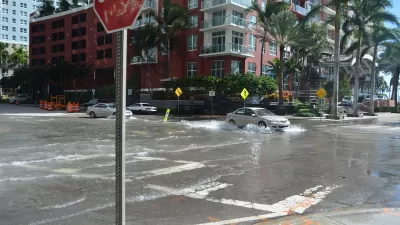After four years of political wrangling, hundreds of public and internal meetings, several revisions, and one determined planning department, consultant team, and Mayor, the City of Miami made urban planning history tonight by adopting the largest known application of a form-based code. In doing so, Miami has catapulted itself to the forefront of those large American cities serious about implementing smart growth.
After four years of political wrangling, hundreds of public and internal meetings, several revisions, and one determined planning department, consultant team, and Mayor, the City of Miami made urban planning history tonight by adopting the largest known application of a form-based code. In doing so, Miami has catapulted itself to the forefront of those large American cities serious about implementing smart growth.
To be sure, certain elements of the code remained controversial, such as a 35 foot height limit proposed--and adopted-- for a large stretch of the city's most important corridor, yet City Commissioners admirably managed to vote 4-1 in favor of officially replacing the city's outmoded use-base zoning code with a form-based code. Interestingly, Sandy Sorlien, a form-based code expert, also reports that the small town of Jamestown, Rhode Island adopted a form-based code this evening.
While dozens of lessons may now be learned from the Miami 21 process, a few other large cities are already ready to ditch their own sprawl inducing codes for a more sustainable pattern of growth. Denver, for example, will likely adopt its own comprehensive form-based code in a matter of months.
Miami 21 is not perfect, but its implementation will allow all practicing planners and advocates of form-based codes alike to study and learn from the successes and failures of Miami's process and eventual results. For that, I hope you can join me in congratulating the City of Miami (and Jamestown) for taking a bold step forward in pursuing a more sustainable 21st century American city.

Manufactured Crisis: Losing the Nation’s Largest Source of Unsubsidized Affordable Housing
Manufactured housing communities have long been an affordable housing option for millions of people living in the U.S., but that affordability is disappearing rapidly. How did we get here?

Americans May Be Stuck — But Why?
Americans are moving a lot less than they once did, and that is a problem. While Yoni Applebaum, in his highly-publicized article Stuck, gets the reasons badly wrong, it's still important to ask: why are we moving so much less than before?

Using Old Oil and Gas Wells for Green Energy Storage
Penn State researchers have found that repurposing abandoned oil and gas wells for geothermal-assisted compressed-air energy storage can boost efficiency, reduce environmental risks, and support clean energy and job transitions.

Minneapolis Bans Rent-Setting Software
Four cities have enacted restrictions on algorithmic software that can inflate rent costs.

Oakland to Add 244 New EV Chargers
Oakland plans to launch its new charging network at eight locations by the end of 2025.

Jane Goodall Inspires with Message of Hope, Resilience, and Environmental Action
Speaking in Pasadena, Jane Goodall offered a hopeful and inspirational message, urging global compassion, environmental responsibility, and the power of individual action to shape a better future.
Urban Design for Planners 1: Software Tools
This six-course series explores essential urban design concepts using open source software and equips planners with the tools they need to participate fully in the urban design process.
Planning for Universal Design
Learn the tools for implementing Universal Design in planning regulations.
Heyer Gruel & Associates PA
City of Moreno Valley
Institute for Housing and Urban Development Studies (IHS)
City of Grandview
Harvard GSD Executive Education
Salt Lake City
NYU Wagner Graduate School of Public Service
City of Cambridge, Maryland




























